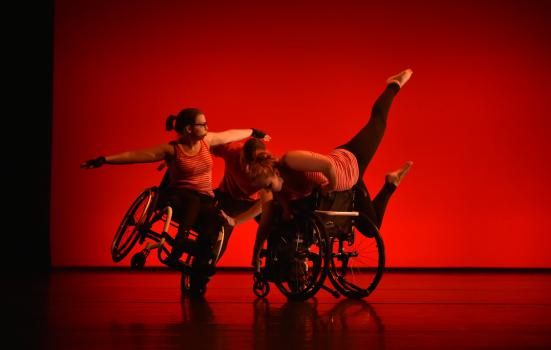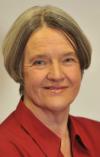Linda Jasper reveals how U.Dance festival got more young disabled performers involved than ever before.

Brian Slater
Youth Dance England (YDE) runs U.Dance, a national performance framework that stimulates performances at local, county, regional and national levels, with over 16,000 young people taking part in 2014/15. An essential part of the framework is a national festival held in a different location each year. This year, the ninth festival took place in Plymouth and was delivered with Plymouth Dance. 247 applications were received from groups, an increase of 17% from the previous year. The groups gave eight regional performances delivered by our partners (Dance City, The Lowry, Yorkshire Dance, Dance4, DanceXchange, Dance East, TrinityLaban & Greenwich Dance, South East Dance and Pavilion Dance SW), which formed the selection events for the national festival. The ongoing popularity of U.Dance perhaps lies in the importance placed on the value of a national framework, particularly in the context of cuts to local provision.
Images of disabled, young dancers were featured on all promotional materials and in a promotional film
This year the festival focused on inclusive dance. While the national youth dance festival has always included disabled dancers, we recognised the need to encourage more inclusive groups to be involved. Working with Plymouth Dance gave us the opportunity to focus on this as it is a network comprising experts in inclusive dance and is proud of Plymouth’s infrastructure where disabled people progress in dance right from first experiences in school to studying for a degree.
The first step we took was to bring together professional, inclusive dance companies Anjali Dance Company, Candoco Dance Company and Stopgap Dance Company to discuss the project. We arrived at proposals on how the festival could be adapted to attract and address the needs of disabled dancers. This led to a paper presented to the National Inclusive Dance Network (NIDN) at conference, asking for views on which approaches would be best to take. NIDN’s involvement in the festival was crucial to ensure that we reached out into the sector to communicate the opportunity and shape the festival.
We gave early consideration to how we would evaluate the impact of the festival and set a target for the number of applications from inclusive groups based on data from previous years. The number of applications had averaged 10%, and using this figure as a benchmark we raised it to 20%. Quantitative data was only part of the information we needed to collect if we were to assess impact, so we decided to appoint an expert external evaluator to survey participants and give feedback on process and progress. Through an open tendering process we commissioned GDance, a production and training company specialising in inclusive practice. One of the benefits was that, as a key partner of NIDN, its evaluation could feed into the Tipping Point national strategy to ensure wider dissemination. In addition, we commissioned GDance to produce a set of guidelines on working with disabled dancers.
The actions we took included the following: images of disabled, young dancers were featured on all promotional materials and in a promotional film; we made explicit our intention to include disabled, young dancers and how the festival would accommodate their needs; we marketed to inclusive dance groups with the support of NIDN; inclusive dance experts were appointed on regional selection panels; we programmed the festival to feature professional, disabled dance artists; communication with inclusive group leaders was prioritised so that individual requirements could be addressed; the national performances were BSL-interpreted and a separate Access Fund was made available to cover accommodation, equipment, travel and carers’ costs.
There was a 36% increase in the number of applications from inclusive groups and 8% of the total participants in the national festival were disabled (greater than the national percentage of 6%). Plymouth Dance ran a local development programme in association with the national festival that included 820 young people, 7% of whom were disabled. The number of inclusive groups showcased at regional and national levels was valued by everyone. One inclusive dance group leader commented: “It’s rare that groups get the opportunity to see and learn from each other’s work in this way.”
One of the key aspects we wanted to address was to change people’s perceptions of disabled, young people dancing. We scheduled Stopgap to perform and stimulate debate with the young dancers. We offered 44 leaders/artists accompanying the young people sessions with expert Sue Smith to help them make their practice more inclusive. In terms of building a legacy, this should have a wide impact on increasing opportunities for disabled, young dancers. We found there was a general openness and desire to see and integrate with more inclusive dance.
U.Dance 2015 raised the expectations of the youth dance sector in the quest to be more inclusive and many lessons were learnt. Scheduling, briefing artists and group leaders and alternative programming were areas that were identified as needing further attention and funding. We found that opportunities for inclusive groups to perform are patchy across the country, which is compounded by the lack of visibility of professional, disabled dance artists. U.Dance raised the bar and there is no going back. We are working with the Association of Dance of the African Diaspora, Dance UK and National Dance Teachers Association to form a new organisation to support the dance industry from next April. U.Dance will be a key programme for the new organisation and the learning from this year will inform its equalities policies and inclusive practice.
Linda Jasper is Director of Youth Dance England.
www.yde.org.uk
For a full report, email U.Dance: u.dance@yde.org.uk




